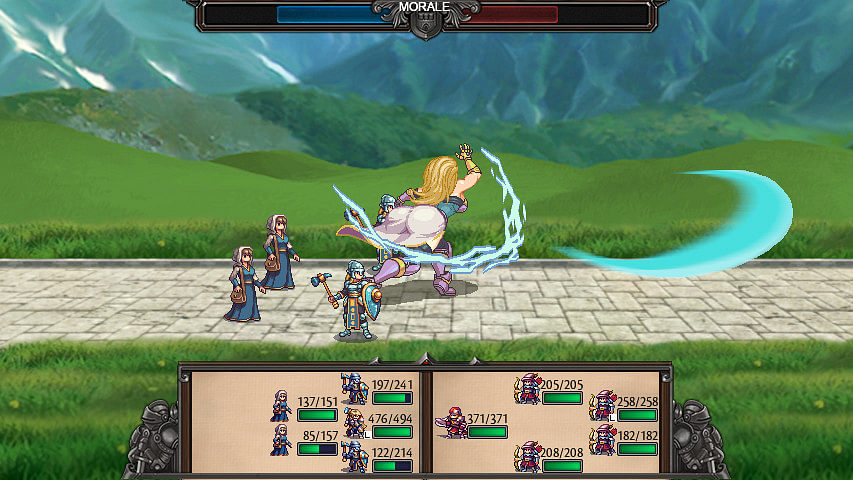
Growing up, my family made a weekly trip to Blockbuster in order to rent some media to keep the kids entertained for the weekend. My brother and I would usually land on getting Godzilla films to fast forward through to the kaiju battles, or we would pick up the strangest Nintendo 64 games we could find. Since the save files for N64 games were usually allocated on the cartridge the game was on, if other renters saved over our save slots all of the progress we made was gone, so we went for the more obscure games to increase the chances that no one would override our saves. Using this strategy we played inscrutable garbage from Japan such as Mystical Ninja Starring Goemon, Mischief Makers and the one odd game that would truly capture our imaginations even into our 30s, Ogre Battle 64: Person of Lordly Caliber. As we've grown into software developers, we have entertained remaking the unique multi-unit, squad based tactical battle mechanics of Ogre Battle 64: Person of Lordly Caliber into a more fine tuned and challenging indie game. Earlier this year I was messaging my brother about his plans for programming this very game after finding a spec design document I had scratched up while bored at an old job, only to be informed he had completely dropped the hypothetical project after discovering that the game we had pondered over ever existing for two decades had been made, and it was called Symphony of War: The Nephilim Saga.

Symphony of War is a turn based tactical RPG that effectively combines the core combat mechanics of the Fire Emblem and Ogre Battle series. I dig both of these franchises, but since Fire Emblem is still going strong to this day, it is more likely that interested gamers are looking to get their Ogre Battle itches scratched. The Fire Emblem approach to the tactical RPG is to give players a plethora of playable characters of different classes, and deploying a limited number of them to engage armies of enemies in single combat. Games like Ogre Battle 64: Person of Lordly Caliber take a more realistic approach in that instead of playable characters fighting each other one on one in battles, each playable character is leading a highly customizable squad of multiple units. It's the infinitely malleable quality of your army's squads and the individual qualities of the units within them that really get the old brain box whirling when playing these games. Ogre Battle 64: Person of Lordly Caliber offered a wide variety of class and ability paths for individual units to grow into, and squad formations rewarded specialization of certain classes, such as flying units or squads composed of monsters led by a beast master that offered buffs. Where Ogre Battle failed was in its difficulty level. Due to the real time strategy elements of its tactical mode, and the lack of multiple mission objectives, creating unique squads was an ancillary element of the game when most of it could be mowed over by the objectively strongest unit in the game, the Paladin, and there was no limit on the number of those you could get in your army. Symphony of War incorporates the best from Fire Emblem and Ogre Battle, with a lemon twist of its own unique features to create a difficult and engaging RPG so long as the right modes are enabled.

Where Symphony of War excels is knowing where to limit the player and where not to limit them. Ogre Battle 64: Person of Lordly Caliber failed in that all of your allied units, once you reach a certain level of advancement in the story and find the right equipment could just be made into Paladins and Wizards. These are advanced units that either attack from the front row of their squad a lot or unleash powerful area of effect magic, and once you reach this point the game is a sweep. Symphony of War limits the amount of powerful units you can have but gives engaging paths to increase your limit. Your army has a pool of resources such as iron, magic gems, gunpowder, horses, etc, and these pools can be expanded upon by capturing mines or stables dotted around the landscape during each battle mission, providing your army with plenty of side objectives and rewarding the creation of the maximum number of squads you can deploy in order to have the extra hands to grab all the resources and still complete main objectives on time or under the suggested turn count for a higher mission ranking. Upgrading to better firearms, cavalry, heavy armor or strong mages requires these resources, so best to stock up as best you can.
Ogre Battle 64: Person of Lordly Caliber also had some missteps in how it expected you to assemble your squads. Each squad had a 3 x 3 grid, nine spaces to place units and squads maxed out at 5 units. Unless you used a large unit which took up more space on the squad and cost two units. In general your melee fighters should be in front, spellcasters in back and any unit that needed to be protected from attacks should be in the middle. The number of attacks was upped based on front or back row unit placement, but the middle row offered no advantage. Hell even the one unit designed to be alright in the middle row, the Doll Masters that buffed large Golem units, could not be utilized to their max effectiveness in a squad with two front row golems, as golems were too big to leave an open middle row. In Symphony of War magic attacks are buffed in the back row but there are a number of reasons to not keep your mages and healers back there if the unit is expected to defend, on account of random targeting ranged squads or assassin style enemy units that can attack your back row directly if they strike first. In a squad where your leader has a high leadership stat and can thus get a high number of followers (up to 9 a squad in this game, with units above 5 requiring ever more leadership from the head of the squad), having a high offense melee front row, a strongly defended back row and a glass cannon magical center is a good way to go. But even this ultra unit may not have the healing capacity to tank the really powerful enemy units, and it may even have a hard time taking out magic based enemy units with a strong front line, so that's when it's a good idea to deploy your own ambushy assassin style squad, or start using guns.

As far as difficulty of the game goes that is really a choose your own adventure. On the three initial difficulties, a basic easy, normal and hard mode, unit permadeath is optional, and with permadeath on, reviving units is an option if the squad does not fall completely, although there is an opportunity cost to rushing injured units back to the revivifying temples in terms of wasting turns retreating them back. If you are going for all mission objectives and still trying to get the spoils that come from getting a high ranking on any given mission (mostly determined by how many turns it took you), having permadeath on will leave you with small gaps in your army as you wont have time for everything. But new units are easy to purchase and a lot of units are not horribly different from the rest, but there will over time be some standouts you would be at a true loss to lose. Individual units are relatively easy to reclass and retool, but their base stats often offer a good direction to go in if you pay attention to their elemental affinities, which determine stat growth rates. One thing I learned quickly is sometimes random recruits and mercenaries that can be purchased are blessed with absolutely mondo leadership stats and can make better squad leaders than the small band of main characters that you get as suggested leaders. It is also not particularly difficult for your units to reach a Tier 3, or highest level, class pretty early in the game, but with how easy it is for units to die, and with quantity being as important a factor as quality, this didn't cause any problems for me, since leveling up a ton of replacement units to higher tiers would be annoying.
The game also features a story and some additional features that open up in relation to it, but I gotta say, I just skip all that shit and fast forward with the "~" key through any dialogue I can't skip. Even on the Fire Emblem games, which I like, I do not give a single shit about the story. I am just here for the armies and the strats. Something's going on with a kingdom and the gods and there are five heroes or some shit. The artwork of the game, outside of the battle animations for sprites, leaves a lot to be desired since every character portrait looks like it was done with no art direction save one: Make the women eight feet tall, give them globular breasts and when the artist is done drawing them the eight foot tall woman materializes out of the computer and steps on the artist while their dick is out.

Despite getting the sense that one part of this game was driven by a very specific fetish of one of the designers, everything about Symphony of War: The Nephilim Saga clicks in just the right way to satisfy a game design fascination I have wanted to see revisited since my childhood. I will no doubt play every DLC and additional difficulty level that comes out because I play games like this for years until I find a new one.
Symphony of War: The Nephilim Saga was designed and developed by Dancing Dragon Games with the help of RPG Maker. It's out on Steam and console ports are on the way.




